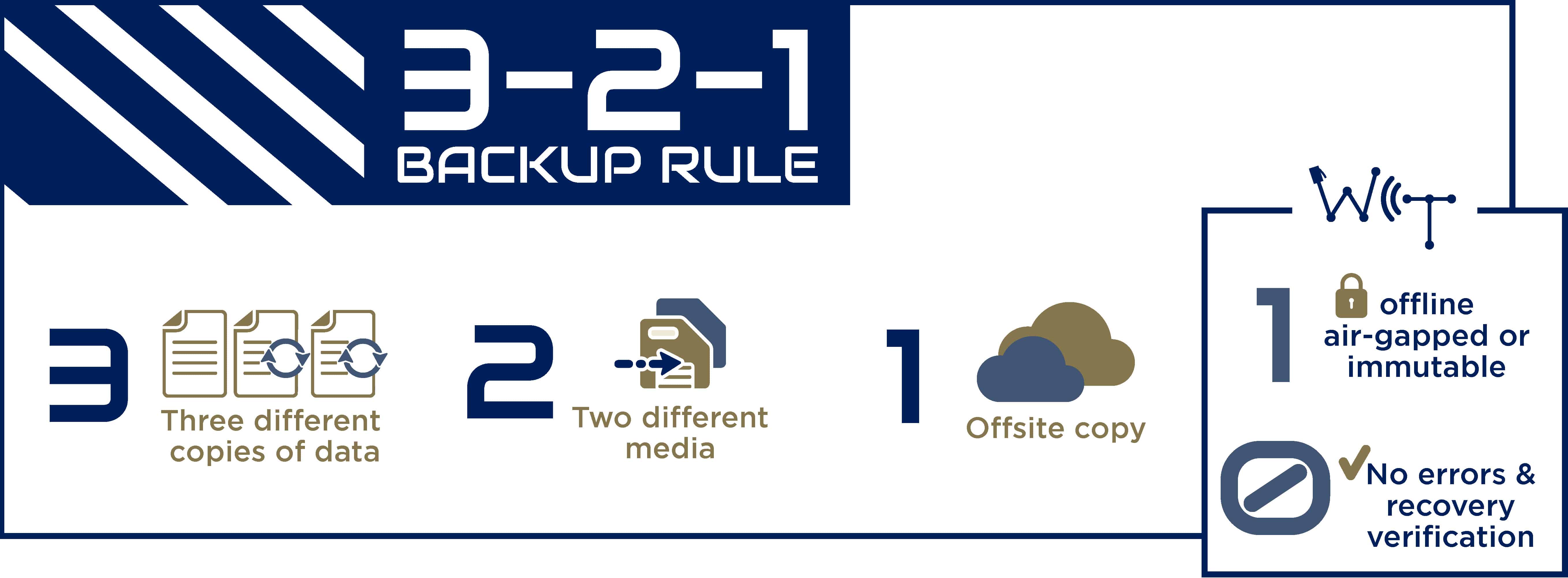
The Power of Backup and Recovery: Is your business prepared for the unexpected? Don’t wait until it’s too late.
In today’s digital economy data reigns supreme, making its protection a non-negotiable priority for businesses. Losing data can spell disaster, impacting productivity, revenue, reputation, and customer loyalty. Waiting for a significant loss before safeguarding data is a risky gamble.
Unfortunately, some business owners are still saving important data in one place and not paying attention to the 3-2-1 backup rule. Saving all your data in one place could spell disaster. Did you know that only 40% of small to medium-sized businesses survive a disaster? (per ConnectWise) That’s a sobering statistic when you consider all the potential threats and bad actors out there, which we have no control over. The rise of cyber threats like ransomware attacks emphasize the need for airtight data protection measures. Hackers can encrypt or compromise sensitive data, holding it hostage until a ransom is paid. With regular backups stored securely and separately from the primary network, businesses can survive such threats by restoring their systems to a pre-attack state, without paying exorbitant ransom demands.
Defining Backup and Recovery
Backup and recovery involve duplicating and securely storing data to restore it in case of loss. It is a fail-safe method to swiftly recover critical information and resume business operations.
Purpose and Working of Backup and Recovery
The purpose of the backup is to create a copy of data that can be recovered in the event of a primary data failure. Primary data failures can be the result of hardware or software failure, data corruption, fire, natural disaster, or a human-caused event, such as a malicious attack (virus or malware) or accidental deletion of data. Backup copies allow data to be restored from an earlier point in time to help the business recover from an unplanned event. A good practice to keep in mind is the 3-2-1 backup rule. This means you have three copies of data, on at least two different types of media, with at least one copy being off-site. Following this rule helps to ensure data security and reliability when data is needed.

Key Components of a Backup and Recovery Plan
Creating a robust backup and recovery plan involves several key components to ensure data protection and continuity in case of system failures, cyberattacks, or unforeseen incidents. Here are the fundamental elements to consider:
- Data Inventory and Classification: Identify all critical data within your organization. Classify it based on its importance and sensitivity. This step helps prioritize what needs immediate backup and recovery measures.
- Backup Strategy: Determine the types of backups needed—full, incremental, or differential—and how frequently they should occur. This includes selecting backup tools, defining backup schedules, and deciding where to store backups (on-premises, in the cloud, or in a combination).
- Retention Policies: Establish guidelines on how long to retain different types of backups. This ensures optimized storage usage and facilitates efficient recovery based on specific timeframes.
- Testing Procedures: Regularly test the backup and recovery processes to ensure their effectiveness. Simulate various scenarios to verify that data can be successfully restored within acceptable time frames.
- Security Measures: Implement encryption techniques to protect backed-up data both in transit and at rest. Access controls, authentication mechanisms, and authorization protocols should also be in place to prevent unauthorized access to backups.
- Disaster Recovery Plan: Develop a comprehensive strategy outlining steps to recover data and restore operations in the event of a disaster. This plan should include roles and responsibilities, communication protocols, and detailed recovery procedures.
- Documentation and Training: Document the backup and recovery procedures comprehensively. Ensure that relevant personnel are trained on these protocols, including how to initiate recovery processes effectively.
- Regular Updates and Improvements: Keep the backup and recovery plan updated to align with evolving technologies, changes in infrastructure, and emerging threats. Periodically review and enhance the plan based on lessons learned from testing and real-world incidents.
- Monitoring and Alerts: Implement monitoring systems that track the status of backups and alert administrators in case of failures or abnormalities. Proactive monitoring helps address issues before they escalate.
By incorporating these components into a comprehensive backup and recovery plan, organizations can mitigate risks, safeguard critical data, and maintain operational resilience in the face of unexpected disruptions.
Investing in a robust backup and recovery plan is not an option; it is a necessity for businesses in the digital age. It’s not if you will ever need it; it’s when you will need your backups. Safeguarding data through reliable backup systems and swift recovery processes is essential for business survival and success. West Central Technology offers a customized, complete backup solution combining on-site and cloud backups, ensuring accessibility and security. As well as automated systems to streamline data protection and verify backup integrity, while offering scalability. Do you have a data backup and recovery solution you can count on? If not, contact West Central Technology today.
Verify, verify, verify! Periodically test the backup systems to ensure data integrity and verify that recovery processes are effective.
